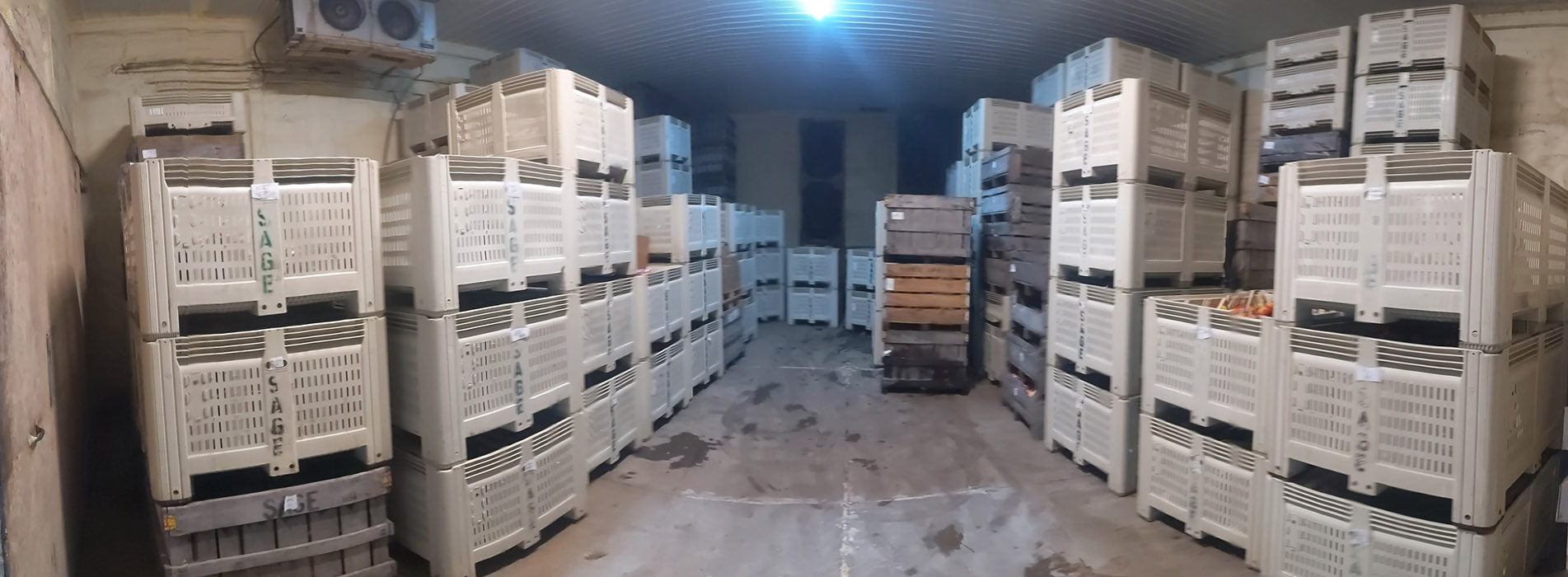Inside our Cooler
A look inside our cooler packed full in November. We have some plastic bins and wood bins.
Fruit must be kept cold and in high humidity to remain hard and flavorful. A refrigerator works well except for the humidity part. To help keep the moisture inside the apple at home you can keep the apples in the plastic bag from our market and add a damp cloth. Additionally, you should tie the handles closed and monitor the damp cloth often and add water to the cloth when needed.
!!Honeycrisp Disclamer!! Honeycrisp are an exception. One of many problems they can develops is browning just below the skin that can be seen form the outside. This is caused when the HONEYCRISP are put into cold storage or a refrigerator too soon afte harvest. To remidy this we keep all Honeycrisp bins out of the cooler for 5-7 days. After this week they can be put into the cooler. This shouldn't be a problem for you unless by chance we sell them before the 5-7 days is up, in early September. There are a few other unknown variables, they don't all, or always turn brown. There are several other browning problems with Honeycrisp not discussed here.

A look inside our cooler packed full in November. We have some plastic bins and wood bins.
Here at Sage’s we utilize several ways to store our apples long into the New Year. We are a strictly retail business and “Apples Are Our Specialty” which makes it imperative for us to have great tasting apples year-round. We utilize several storage methods to ensure our crop remains superior. Storage conditions always start with great tasting apples. This is where we have an edge on the competition with our longer growing season provided by the combination of our proximity to Lake Erie and our elevation. Our apples ripen in the fall several weeks longer than an apple grown just 40 miles south of us. Once you taste our apples you will agree that flavor is everything and our apples have it!
If you are wondering just how a longer growing season can add flavor to an apple consider what gives produce flavor. In general it is the complex arrangement of flavonoids and antioxidants, vitamins and minerals that give flavor to fruits and vegetables. These are all drawn into the fruit toward the end of the ripening process and all except the minerals are produced there through the maturation process.
Harvest: Once they are harvested we cool them down as soon as we harvest them to ensure flavor retention. A few hours in the sun can reduce flavor and storage greatly. Our more than 50 varieties are each harvested with as much flavor as possible.
Cold Storage: Our storage cooler will hold about 6500 Bushels of apples. We keep the cooler around 32F with high humidity to keep them fresh and juicy. An apple will freeze around 28F because of the high amounts of natural sugar. Much of our crop stored in our Cold Storage is sold through the fall and into January and February. The ripening process continues in storage for apples and by this time many varieties have lost their “snap”. We strive to always sell the best quality apples but it is always hard to know just how they will do once they leave our Cold Storage. This has influence from the past fall and harvest time as well as cultural practices that we must take into account.
Fuji, Melrose, Evercrisp and Goldrush are two varieties which remain crisp and juicy in Cold Storage well into the Spring. FYI
Controlled Atmosphere Storage: In 1940 Dr. Robert Smock of Cornell University experimented with reducing the ripening process of fruit (apples) by lowering their respiration rate. Remember how we breathe; apples do the same. The normal atmosphere is 21% oxygen and 0.25% carbon dioxide. Dr. Smock determined that by reducing the oxygen from 21% to 2.5% and the increasing carbon dioxide from 0.25 to 2-5% the produce dramatically maintained crispness and flavor, thus slowing the respiration rate.
These CA Storage rooms must be air tight and have precise metering equipment to maintain the levels necessary to nearly stop the respiration rate of fruit. We at Sage’s do not have our own CA rooms and can not justify the expense for our retail business. However, through GreenStar Coop we are able to network with other Ohio growers to make the CA storage economical. GreenStar has many rooms which are opened systematically through the spring about once a month. We are then able to take out what we need for the next month. It is important to understand that these apples once returned to the normal atmosphere will begin ripening as normal. While we always want our customers to receive the best it is necessary to understand the possibility of fruits to be more ripe than desirable in the spring. However, as we take more bins of our apples out of CA Storage they will be harder and crisper again for a few weeks. So keep coming back.
It is best for this reason to take extra care of apples in the spring:
By keeping them as cold as possible at all times.
Understand they will not keep as long on the table as they did in the fall.
It would also be a great idea to only buy as many as you can eat in 1 week.
When the apples you have are not as hard as desired know that we will have more hard ones soon. Simply eat them more quickly or buy a smaller amount in the Winter and Spring becuase we can store them better in our cooler.